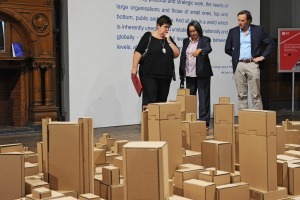The Foreshore reimagined
25 April 2014 | Story by Newsroom
Have you ever imagined the Cape Town Foreshore sans the unfinished highways?
UCT students certainly have. Their ideas of a reimagined Foreshore were part of a display at the recent Future Foreshore Exhibition which took place in the City Hall this month.
Designs reflected many different approaches. Some emphasised function, some favoured form in equal measure, and all were as bold as the City had hoped. Some students mooted buildings and roads that harvest solar and kinetic energy to generate electricity, while others envisioned greening the spaces below the unfinished highways.
The idea for the project began percolating in late 2012 when Transport for Cape Town (TCT), the local government authority responsible for revamping Cape Town's public transport, approached UCT's Faculty of Engineering & the Built Environment (EBE), to ask if its students would spearhead the reimagining of the Foreshore in partnership with the City.
'Working on a live project'
Dubbed the Future Foreshore Project and using the 2013 curricula, some 600 students eventually presented the City with numerous plans for the iconic Cape Town cityscape.
"It gave the students a chance to work on a live project that was a real issue for the city," says Professor Vanessa Watson, EBE deputy dean.
"It also gave us a chance to get students to work in an interdisciplinary way," adds Watson, who also curated the exhibition.
"We worked with architects, we worked with urban designers, we worked with landscape architects and we had to come up with ideas from there," explains Samantha Lee, a master's student in city and regional planning.
Lee's classmate, Chadernnay Brink, says working on UCT-TCT collaboration as part of her degree opened up new horizons about how she thought about her field.
"We had to change the way we think about cities and the way they function, and what makes it work well," says Brink, whose academic background is in environmental and geographic sciences. "We thought that Cape Town was an amazing place, but you learn that it was not planned well, and it excludes lots of people form the outskirts of the city, because we only have one CBD."
'A very segregated city'
Says Lee: "Cape Town used the apartheid planning model, so it's very segregated, and the Foreshore freeways at a time when [planners] thought cars were the future, and it's okay to destroy the world with all this petrol munching, and now we're realising that something's wrong there.
"Our class looked at the fact that we can't continue this, because that will only exacerbate the effects of climate change and global warming."
The students also worked within the City's framework of creating a greener space, says Lee.
"If you look at our entire class's projects, nobody completed the freeways," says Brink. Most people brought the freeways down to ground level, allowed the sea to reclaim that land (some might recall the docks at the bottom of Long Street in yesteryear), or created urban parks instead.
Sustainability was the theme, says Brink.
This was demonstrated by the number of projects which centred on a Foreshore that harnessed the energy of both the sun and the traffic to generate electricity.
Creativity and open minds
Brett Herron, the City's mayoral committee member for transport, roads and stormwater, said that the City had laid few parameters for the students, "wanting to fully tap into [their] creativity and open minds".
The Foreshore, said Herron, had the potential to unlock enormous opportunity for all who lived in the city, if it was treated correctly.
"We could quite easily have put a tender out on the market and awarded a contract for the conceptual framework for the Foreshore, and I've no reason to believe that we wouldn't have been pleased ... had we gone our usual route. But we were not looking to be pleased and usual," said Herron.
Herron was grateful to the Professor Francis Petersen, EBE dean, and the students, for enthusiastically taking to the task.
When the exhibition closes, the projects will officially be handed over to the city for consideration. In the meantime, the public is free to peruse the plans, which share the second floor of City Hall with a to-scale model of the Foreshore made from cardboard.
Participating students hailed from a range of disciplines including architecture, urban planning, landscape architecture, urban design, quantity surveying, construction economics, civil engineering, chemical engineering and electrical engineering.
Story by Yusuf Omar. Image by Michael Hammond.
 This work is licensed under a Creative Commons Attribution-NoDerivatives 4.0 International License.
This work is licensed under a Creative Commons Attribution-NoDerivatives 4.0 International License.
Please view the republishing articles page for more information.










